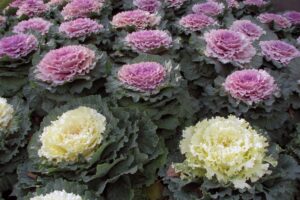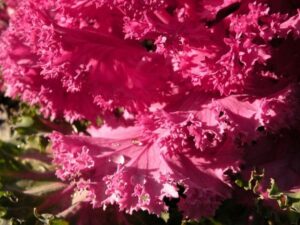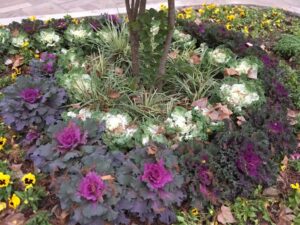Brassica Oleracea (Ornamental Cabbage and Kale)
go.ncsu.edu/readext?1072936
en Español / em Português
El inglés es el idioma de control de esta página. En la medida en que haya algún conflicto entre la traducción al inglés y la traducción, el inglés prevalece.
Al hacer clic en el enlace de traducción se activa un servicio de traducción gratuito para convertir la página al español. Al igual que con cualquier traducción por Internet, la conversión no es sensible al contexto y puede que no traduzca el texto en su significado original. NC State Extension no garantiza la exactitud del texto traducido. Por favor, tenga en cuenta que algunas aplicaciones y/o servicios pueden no funcionar como se espera cuando se traducen.
Português
Inglês é o idioma de controle desta página. Na medida que haja algum conflito entre o texto original em Inglês e a tradução, o Inglês prevalece.
Ao clicar no link de tradução, um serviço gratuito de tradução será ativado para converter a página para o Português. Como em qualquer tradução pela internet, a conversão não é sensivel ao contexto e pode não ocorrer a tradução para o significado orginal. O serviço de Extensão da Carolina do Norte (NC State Extension) não garante a exatidão do texto traduzido. Por favor, observe que algumas funções ou serviços podem não funcionar como esperado após a tradução.
English
English is the controlling language of this page. To the extent there is any conflict between the English text and the translation, English controls.
Clicking on the translation link activates a free translation service to convert the page to Spanish. As with any Internet translation, the conversion is not context-sensitive and may not translate the text to its original meaning. NC State Extension does not guarantee the accuracy of the translated text. Please note that some applications and/or services may not function as expected when translated.
Collapse ▲Brassica oleracea (Ornamental cabbage and kale)
Article by Extension Master Gardener℠ volunteer Kathryn Copley
Ornamental cabbage and kale are great for replacing worn-out summer annuals for a long-lasting fall display of large rosettes of white, pink, purple or red leaves. Ornamental cabbage and kale (also known as “flowering” cabbage and kale) are in the same species (Brassica oleracea) as edible cabbage, broccoli, and cauli-flower, but cultivars with colored leaves are considered ornamental rather than edible.
Technically, ornamental cabbage and kale are all kales (kales produce leaves in a tight rosette; cabbages produce heads). But in the horticultural trade, ornamental kale is the term used for types with deeply-cut, curly, frilly or ruffled leaves. Ornamental cabbage is the term used for types with broad, flat leaves that are edged in a contrasting color.
Some ornamental varieties of cabbage / kale are:
- ‘Coral Prince’ — creamy white center surrounded by feathery green leaves
- ‘Coral Queen’ — deep red center surrounded by green leaves
- ‘Nagoya’ — red, white or rose center with fringed purplish-green leaves
- ‘Redbor’ — deep purple color.
Ornamental cabbages and kales do not tolerate summer heat, so in USDA zone 8a, purchase transplants in the fall at your local garden center. Until cool weather arrives, plants won’t have much color; leaf colors will intensify as the temperatures start to get cold. White, pink, or red pigments will begin to develop when temperatures dip below 50°F. Once acclimated in a site, ornamental cabbages and kale can survive temperatures as low as 5°F, so plants may last into spring.
These plants grow approximately 12-in. wide and 15-in. tall. Purchase plants appropriately sized for the location because plants will generally not get much bigger after they are planted in the garden, particularly if the roots are pot-bound.
When temperatures start cooling down, plant ornamental cabbage and kale in a sunny spot in moderately moist, rich soil. Prepare soil by incorporating 3 to 4 inches of organic matter and 2 pounds of a slow-release, 12-6-6 fertilizer per 100 square feet of bed space. Space them according to label recom-mendations – normally 12- to 18-in. apart. Bury stems so that the lowest leaves of the plants are flush with the soil sur-face. After planting, keep the plants well-watered. Add a good layer of mulch after planting to help stabilize soil temperatures and conserve moisture.
Position plants to best expose their colorful centers. Use them in mass plantings, in mixed or single container plantings, and as edgings. They look beautiful in the front of a border when combined with perennials that are at their peak in the fall, such as little bluestem grass (Schizacrium scoparium); tall, dark-leaved sedums (Sedum spp.); or asters (Aster spp.). For an easy and attractive container planting, place an ornamental cabbage or kale in the center of a container and surround it with pan-sies. Or try them with other plants that can tolerate light frosts (e.g., Swiss chard, snapdragons, petunias, or chrysanthemums).
Cabbage worms, cabbage loopers, flea beetles, slugs, aphids, and caterpillars are insects that may affect the plants’ health. However, because ornamental cabbage and kale are typically grown late in the growing season, they usually have fewer problems with these pests than if they were grown earlier in the year.
Resources
- NC Extension Gardener Plant Toolbox:
- Wisconsin Extension: Ornamental Cabbage and Kale
- Georgia Extension: Brassicas taking center stage with kale, mustards and collards
By Kathryn Copley, Extension Master Gardener SM Volunteer, Brunswick County, NC. For more information on gardening in Brunswick County, please call the Brunswick County Cooperative Extension Office 910-253-2610






